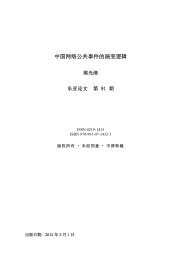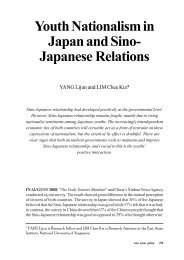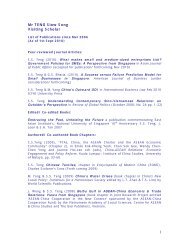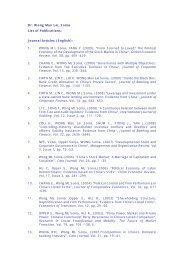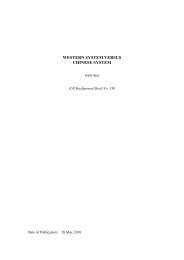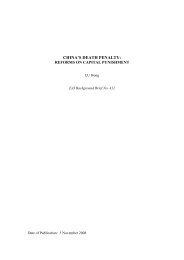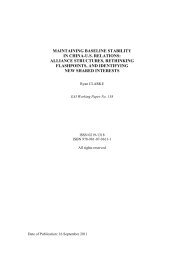Understanding China's Middle Class and its Socio-political Attitude
Understanding China's Middle Class and its Socio-political Attitude
Understanding China's Middle Class and its Socio-political Attitude
You also want an ePaper? Increase the reach of your titles
YUMPU automatically turns print PDFs into web optimized ePapers that Google loves.
TABLE 1 CHANGING CLASS STRUCTURE IN CHINA, 1949-2006 (%)<strong>Class</strong> structure 1949 1952 1978 1988 1991 1999 2001 2006Leading cadres <strong>and</strong> 0.5 0.5 1.0 1.7 2.0 2.1 2.1 2.3government officialsManagerial personnel 0.4 0.1 0.2 0.5 0.8 1.5 1.6 1.3Private entrepreneurs 0.4 0.2 0.0 0.0 0.0 0.6 1.0 2.6Professionals 2.6 0.9 3.5 4.8 5.0 5.1 4.6 6.3Clerical workers 0.5 1.3 1.7 2.3 4.8 7.2 7.0Self-employed 3.7 4.1 0.0 3.1 2.2 4.2 7.1 9.5Sales <strong>and</strong> service worker 0.5 3.1 2.2 6.4 9.3 12.0 11.2 10.1Manual worker 2.9 6.4 19.8 22.4 22.2 22.6 17.5 14.7Agricultural labour 88.1 84.2 67.4 55.8 53.0 44.0 42.9 50.4Semi-/Unemployed 1.3 - 4.6 3.6 3.3 3.1 4.8 5.9Total population 0.54 0.57 0.96 1.11 1.16 1.26 1.28 1.31(N unit: billion)Note: Figures collected from Report on Social <strong>Class</strong> Study in Contemporary China (2002) <strong>and</strong>Social Structure of Contemporary China (2010), both edited by Lu, Xueyi, Institute of<strong>Socio</strong>logy, CASSFIGURE 1 CHINA’S MIDDLE CLASS, 1949-2006Source: National Bureau of Statistics <strong>and</strong> China General Social Survey (by CASS) 200652 east asian policy
FIGURE 2 PROPORTIONS OF NEW, OLD AND MARGINAL MIDDLECLASS’ SATISFACTION WITH LIFE IN 2006Source: China General Social Survey (CGSS) 2006lifestyle despite the social policy reform, the force of democratisation is unlikely tobecome strong.Life Satisfaction of China’s <strong>Middle</strong> <strong>Class</strong>As the majority of the middle class are business professionals, government officials<strong>and</strong> intellectuals, most of them ranked career <strong>and</strong> professional life highly in their sociallife. They ordinarily expect long term employment <strong>and</strong> regard working life as one of thetop priorities. Recent research found that they are dependent on the current economicsystem, generally have savings in banks <strong>and</strong> lead a comfortable life.Figure 2 shows that about 77% of new middle class are satisfied with their currentlife, in comparison to 73% of old middle class <strong>and</strong> 68% of marginal middle class.Similar patterns are also found in some particular aspects of life such as family financialsituation, housing <strong>and</strong> current job. More new middle class claim satisfaction with theirlife than old <strong>and</strong> marginal middle class. Therefore, in terms of happiness (Figure 3), onaverage, over 50% of middle class are happy with their life, compared with around44% of working class <strong>and</strong> 42% of agricultural labour. Of the middle class, the newmiddle class is again found to be the happiest group.Respondents were fairly humble when they were asked to rank their personaleconomic status <strong>and</strong> family socio-economic status in society, as shown in Figure 4.About 46% of new middle class <strong>and</strong> 42% of old middle class ranked their personaleconomic status as well as their family socio-economic status as middle or upper levelof Chinese society. Meanwhile, for the less confident marginal middle class, both figuresdrop to around 30%.east asian policy 53
FIGURE 3 HAPPINESS OF CHINESE PEOPLE IN 2006Source: China General Social Survey (CGSS) 2006FIGURE 4 CHINESE PEOPLE’S SELF-RANKING IN 2006Source: China General Social Survey (CGSS) 2006However, very few people that were defined as middle class actually claimedthemselves as middle class. As shown in Figure 4, only 17.6% of new <strong>and</strong> old middleclass identified themselves as middle class, <strong>and</strong> the proportion drops to nine percent formarginal middle class. In fact, 54% of new middle class claimed themselves as workingclass, while the proportion increased to 76% among the marginal middle class, with54 east asian policy
around 11% of both groups claiming to be agricultural labour. At the same time, for theold middle class, about 41% claimed to be working class while about 35% claimed tobe agricultural labour.There are two possible explanations to this phenomenon. One is modesty. Therespondents could be too humble to label themselves as middle class. The second isthis genuine feeling of inadequacy brought about by the heavy burden of housing loans<strong>and</strong> high costs of living. Some commentators have warned that if housing price increaseskeep out-pacing growth of income or savings, in five to eight years’ time, the majorityof urban middle class in China will be gradually squeezed out of the housing market.The majority of middle class will slip to a vulnerable position as in the case of Japan.The social structure would then be in the shape of “I” instead of an “olive’ or “onion”.The identity of China’s middle class has yet to be formed, resulting in a discrepancyin the size of objective <strong>and</strong> subjective middle class groups. Soaring housing prices <strong>and</strong>costs of living strongly affect people’s perception of their own class status <strong>and</strong> theirsocio-<strong>political</strong> preferences. It is evident that a number of China’s middle class are stillstruggling to make ends meet. Nonetheless, some segments, particularly the financiallymore secured new middle class, are becoming more confident. It would benefit theChinese government if this group continues to grow <strong>and</strong> becomes a stabilising force,<strong>and</strong> provides mainstream values to the rest of the society.More middle class people claim satisfaction with their financial status, job, housing<strong>and</strong> overall life. Therefore, they appear to be living a happier life than the rest of thesociety. The self-evaluation of these aspects of life from a high to low range of satisfactioncorresponds with the order of new, old <strong>and</strong> marginal middle class groups.<strong>Socio</strong>-<strong>political</strong> <strong>Attitude</strong>s of China’s <strong>Middle</strong> <strong>Class</strong>With the rapid growth of China’s middle class, there has been growing interest in thesocio-<strong>political</strong> attitudes of this rising group since the 1980s. Early studies of the emergingmiddle class described them as the most active pursuers of democracy. In the 1990s,mainstream perception had it that the middle class was supportive of government policies<strong>and</strong> economic reform, as well as <strong>political</strong>ly conservative; they would therefore becomea strong stabilising force of the society.Most recent research shows that China’s middle class actually hold a mix of bothliberalistic <strong>and</strong> conservative views due to their divergent backgrounds <strong>and</strong> lifeexperiences. They tend to have more positive feelings about democracy <strong>and</strong> highexpectation of social justice, <strong>and</strong> show higher confidence in participating in politics.Most of them hope to benefit from the economic growth <strong>and</strong> maintain their currentlifestyle; they are therefore more prepared to be subservient to an authoritarian state foreconomic security <strong>and</strong> socio-<strong>political</strong> stability (Table 2).Table 2 shows that the middle class as a whole appears to be more open-mindedregarding the pursuit of democracy (S1), <strong>and</strong> has more confidence in participating inpolitics (S4) than the working class <strong>and</strong> agricultural labour class. They are aware of theincome gap <strong>and</strong> agreeable to taxing the rich to help the poor; they also show a higherrate of acceptance to the pursuit of profit to sustain economic growth.east asian policy 55
TABLE 2 VIEWS ON SOCIO-POLITICAL ISSUES: MIDDLE CLASS(MC) VERSUS WORKING CLASS AND AGRICULTURAL LABOURCLASS (WC+ALC)I. Regarding democracy <strong>and</strong> <strong>political</strong> participation% of agreement among MC % ofNew Old Marginal All MC WC+ALCS1: Democracy is not necessary with sustainable 33 40 37 36 44economic growthS2: The richer have more rights to speak on public 39 47 41 41 43issues than the poorerS3: Only professionals can exercise the rights of 50 54 50 51 54decision-makingS4: Politics is too complicated to underst<strong>and</strong> 43 54 51 48 59S5: Rights to appeal regarding inadequate local policies 85 83 84 84 81II. Regarding current governmentS6: Insufficient policies are key reasons for poverty 72 70 75 73 73S7: Obedience to government never goes wrong 56 55 58 57 61S8: Operation of law requires government’s support 79 81 84 81 81<strong>and</strong> coordinationIII. Regarding social inequalityS9: No social development without pursuit of prof<strong>its</strong> 76 72 77 76 69S10: Enlarging rich-poor gap stimulates positivity at work 59 59 60 59 58S11: Lack of education is a key reason for poverty 60 63 61 61 65S12: Tax the rich to help the poor 76 73 79 77 77Source: China General Social Survey (CGSS) 2006Within the middle class, there are also differences in socio-<strong>political</strong> attitudes. Thenew middle class with more cultural capital shows most democratic consciousness.The old middle class tend to be more mindful of their own financial situation. They holdrelatively conservative <strong>political</strong> views <strong>and</strong> are more likely to support state authoritarianism<strong>and</strong> have the least consciousness of social inequality <strong>and</strong> justice. The marginal middleclass are comparatively more vulnerable <strong>and</strong> therefore more sympathetic towards thelower class, exhibiting a stronger sense of social justice <strong>and</strong> democracy than the oldmiddle class.In China as in elsewhere, education is positively correlated to liberalism. Youngerpeople have displayed more democratic consciousness <strong>and</strong> lower confidence in thegovernment. Seen in this light, whether the rising middle class is a stabiliser or a challengerwill depend on whether the <strong>political</strong> system can accommodate their <strong>political</strong> dem<strong>and</strong>s.The rise of the bourgeois is also regarded as a potential driving force fordemocratisation. Some scholars speculate that continued economic growth <strong>and</strong> theincreasing scale <strong>and</strong> scope of state enterprise privatisation might ultimately lead to <strong>political</strong>56 east asian policy
changes initiated by private entrepreneurs. Some scholars however believe that China’sprivate entrepreneurs are too heterogeneous to form a cohesive identity. For the pastthree decades, the CCP government has been slowly whittling away the institutions thatdefined the planned economy to embrace market mechanisms. This has reinforcedproperty relations between central <strong>and</strong> local governments, <strong>and</strong> further engenderedcooperative relationships between local officials <strong>and</strong> the businesspeople. Therefore,class formation has not occurred within this group <strong>and</strong> it is unlikely for privateentrepreneurs to promote democratisation in China in the near future.Along with these changes <strong>and</strong> gradual privatisation was the central government’sstrategy for granting greater autonomy over the local economy to local governments.This transformed the relationship between local officials <strong>and</strong> private entrepreneurs fromcritical to an interdependent patron-client relationship.Chinese entrepreneurs have also adopted a series of adaptive strategies <strong>and</strong>maintained close ties with local government officials, which essentially prevent themfrom being a force for change. As Dickson, Bruce J. pointed out in his article on“Integrating Wealth <strong>and</strong> Power in China: The Communist Party’s Embrace of the PrivateSector” (2007), as long as private entrepreneurs share the same interest of promotingeconomic growth, “many will rely heavily on government patronage for their success inmaking prof<strong>its</strong>” <strong>and</strong> “they are among the Party’s most important bases of support”.Consequently, both sides in this debate commonly agree on the Party’s embrace of theprivate sector <strong>and</strong> the impact of entrepreneurs as a new social group.China’s middle class has grown to become a major component in urban China. Thesize of the middle class indicates how sustainable the economic growth has been. Modern<strong>political</strong> economists consider a large middle class with better education <strong>and</strong> underst<strong>and</strong>ingof democracy <strong>and</strong> politics, as well as capability of self-justification, to be a beneficial<strong>and</strong> stabilising influence on society. And the relatively open mobility within the entiremiddle class provides a perfect buffer zone for the confrontation between the topleadership <strong>and</strong> the mass, which further maintains <strong>political</strong> stability.China’s middle class is a mix of liberalists <strong>and</strong> conservatists with divergentbackgrounds <strong>and</strong> life experiences. They tend to have more positive feelings aboutdemocracy <strong>and</strong> high expectation of social justice, <strong>and</strong> show more underst<strong>and</strong>ing <strong>and</strong>readiness to participate in politics. The middle class as a whole appears to be lessconfident of <strong>its</strong> class status in society. The middle class identity has yet to be formed inChina.However, they also hope for stability <strong>and</strong> to benefit from economic growth; they areprepared to be subservient to the authoritarian state for economic security <strong>and</strong> socio<strong>political</strong>stability. As economic conditions largely affect people’s perception of classstatus, they will further shape a person’s socio-<strong>political</strong> attitude. The financially moresecured new middle class is the probable social stabilisers the Chinese governmentmay count on in the future. east asian policy 57



